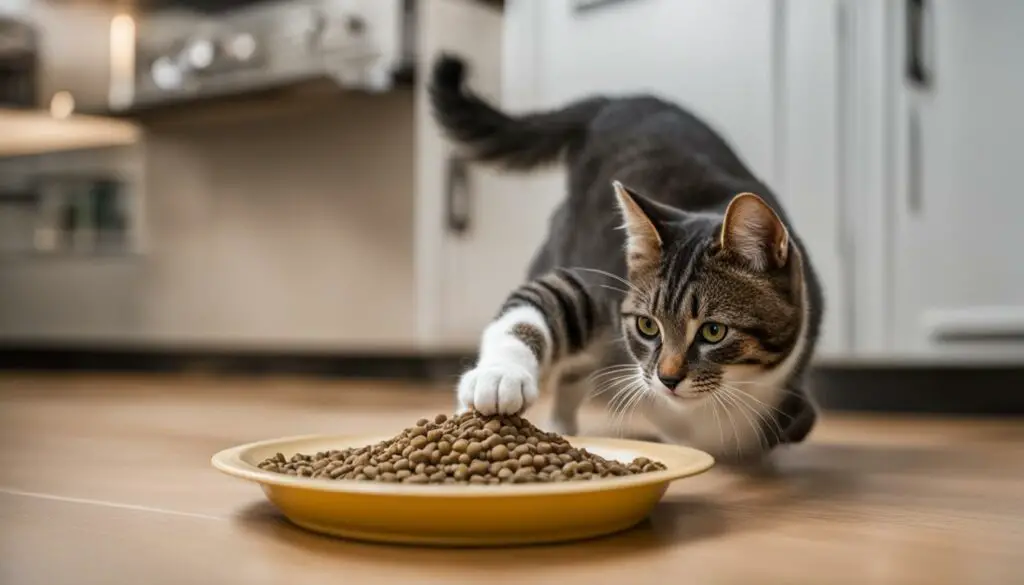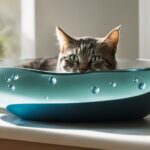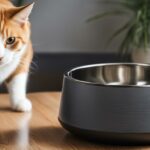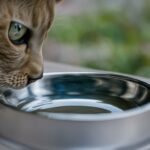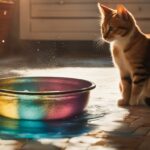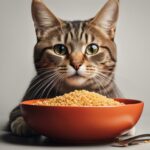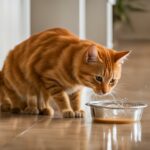If you’ve ever wondered why your cat makes a habit of flipping their food bowl, you’re not alone. This common behavior can be frustrating for pet owners, but understanding the reasons behind it can help you address the issue and find solutions to prevent food bowl flipping in your cat.
There are several possible reasons why cats engage in this behavior. Some cats may be uncomfortable with small or narrow bowls that cause discomfort during mealtime. Others may flip their food bowls as a way to seek attention from their owners, especially when there are changes in the household that reduce their access to attention. Additionally, cats may flip their food bowls if they don’t like the food or the bowl itself, or if they are experiencing anxiety or stress.
To prevent food bowl flipping, it’s important to consider your cat’s specific needs and preferences. Providing a wide, shallow bowl made of materials that your cat prefers can help. Addressing any underlying anxiety or stress in your cat is crucial as well. By understanding your cat’s behavior and implementing appropriate solutions, you can create a positive feeding experience for both you and your feline companion.
Key Takeaways:
- Flipping food bowls can be caused by discomfort, attention-seeking, dislike of food or bowl, or anxiety in cats.
- Offer a wide, shallow bowl made of materials your cat prefers to prevent food bowl flipping.
- Provide dedicated playtime and attention to your cat to reduce attention-seeking behaviors.
- Experiment with different food options to find what your cat enjoys to prevent food bowl flipping due to dislike of the food.
- Consult with a veterinarian or pet behaviorist if you suspect your cat’s flipping behavior is related to underlying anxiety or stress.
Cats Flip Their Food Bowls to Get Attention
Some cats flip their food bowls as a way to get attention from their owners. This behavior is often seen when there are changes in the household that reduce the cat’s access to attention, such as the arrival of a new family member or a decrease in quality time spent with the cat. To prevent food bowl flipping for attention, it is important to provide dedicated playtime and attention to your cat on a regular basis.
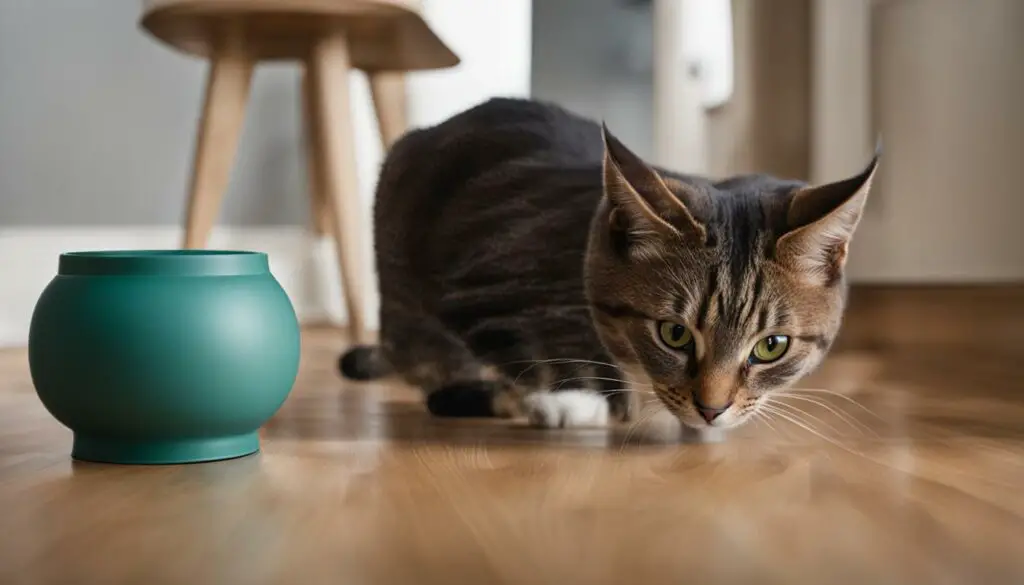
Spending quality time with your cat through interactive play sessions can help fulfill their need for attention. Engage in activities that your cat enjoys, such as interactive toys, laser pointers, or feather wands. This will not only provide mental stimulation but also strengthen the bond between you and your cat.
In addition to playtime, make sure to set aside specific times each day for focused attention. This can include grooming your cat, talking to them, or simply sitting with them and giving them gentle rubs. By consistently providing attention and meeting your cat’s needs for interaction, you can reduce attention-seeking behaviors such as food bowl flipping.
| Preventing Food Bowl Flipping for Attention |
|---|
| 1. Dedicate regular playtime to your cat with interactive toys. |
| 2. Set aside specific times each day for focused attention, such as grooming or gentle rubs. |
| 3. Strengthen the bond between you and your cat through positive interactions. |
| 4. Be consistent in meeting your cat’s needs for attention and interaction. |
Cats Flip Their Food Bowls If They Don’t Like the Food
If your cat is a picky eater, they may flip their food bowl as a sign of displeasure. Cats have their own food preferences and may not enjoy the food you are providing. To prevent food bowl flipping due to dislike of the food, it’s essential to offer a variety of options and find the ones your cat enjoys. Wet food or a combination of wet and dry food is generally recommended for cats, as the moisture content can be more appealing to them. Experimenting with different brands and flavors can help prevent food bowl flipping caused by food aversion.
Observe your cat’s eating habits and preferences to understand what types of food they enjoy the most. Some cats may prefer fish flavors, while others may prefer poultry or beef. By catering to your cat’s food preferences, you can reduce the likelihood of them flipping their food bowl out of dislike.
Picky Eater Cat Food Preferences:
- Offer a variety of food options
- Experiment with different brands and flavors
- Observe your cat’s preferences for fish, poultry, or beef
- Consider wet food or a combination of wet and dry food
Remember, each cat is unique, and their food preferences may vary. It’s essential to provide a balanced and nutritious diet that meets their specific dietary needs while also taking into account their individual tastes. If you are unsure about your cat’s dietary requirements or need guidance on finding the right food for them, consult with your veterinarian.
Creating a positive feeding experience for your cat can help prevent food bowl flipping. By addressing their preferences and offering a variety of options, you can ensure that mealtime is enjoyable for your cat, encouraging them to eat without the need for flipping their food bowl.
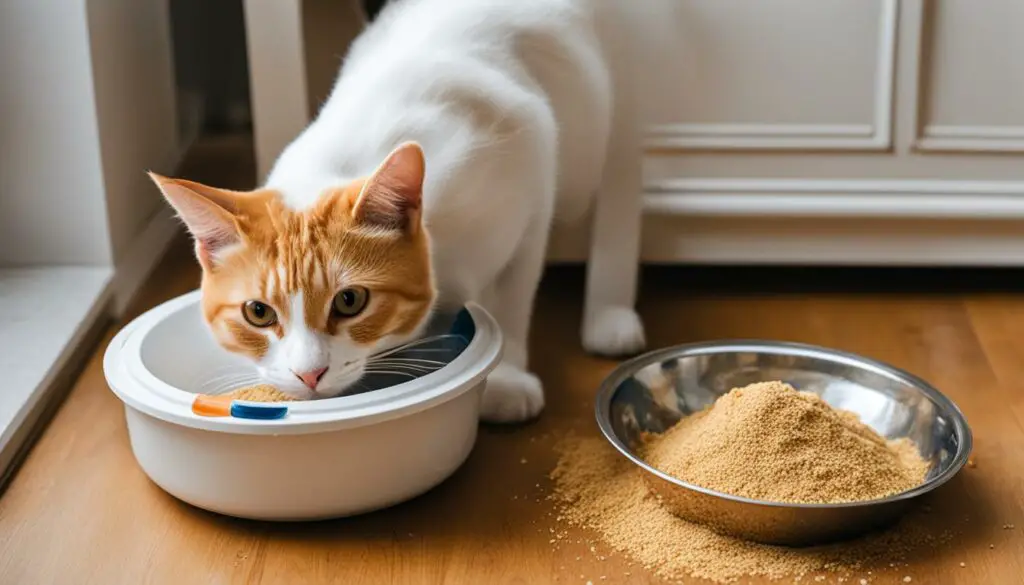
Cats Flip Their Food Bowls If They Don’t Like the Bowl Itself
When it comes to food bowl flipping, the type of bowl you use can play a significant role. Cats can be picky about their bowls and may not like certain shapes, sizes, or materials. For example, some cats may not enjoy eating from deep or narrow bowls that touch their whiskers while they eat. To prevent food bowl flipping, it’s important to choose a bowl that your cat is comfortable with.
Consider opting for a wide and shallow bowl that allows your cat to eat without their whiskers touching the sides. Materials also matter. BPA-free plastic, ceramic, or metal bowls are popular choices for cats. Experiment with different options to find the bowl that your cat prefers.
To help you choose the right bowl, here’s a table comparing different cat bowl materials:
| Bowl Material | Advantages | Disadvantages |
|---|---|---|
| Ceramic | Durable, easy to clean, and doesn’t retain odors | Can chip or break if dropped |
| BPA-free Plastic | Lightweight, affordable, and comes in various designs | May retain odors and can develop scratches over time |
| Metal | Durable, easy to clean, and resistant to scratching | Can be noisy and may feel cold to the touch |
Remember, providing a bowl that your cat likes and feels comfortable with can go a long way in preventing food bowl flipping behavior.
Cats Flip Their Food Bowls Due to Anxiety
Some cats flip their food bowls as a result of anxiety. Cats can experience anxiety due to various factors, such as illness or physical pain, trauma, poor socialization, or separation anxiety. When cats are anxious, they may exhibit behaviors like food bowl flipping as a way to cope with their stress or frustration. It is essential to address the underlying cause of anxiety in your cat to prevent food bowl flipping and promote their overall wellbeing.
One way to address anxiety in cats is by creating a calm and secure environment for them. Providing hiding spots, such as cat trees or cardboard boxes, can give your cat a safe space where they can retreat and feel more at ease.
Using pheromone diffusers, which release synthetic pheromones that mimic the scent of a mother cat, can also help reduce anxiety in cats. These diffusers can create a sense of familiarity and comfort for your cat, helping them feel more relaxed in their surroundings.
Consulting with a veterinarian or a pet behaviorist is highly recommended if your cat is experiencing anxiety. They can provide professional guidance and recommend appropriate strategies or therapies to address your cat’s anxiety and prevent food bowl flipping.
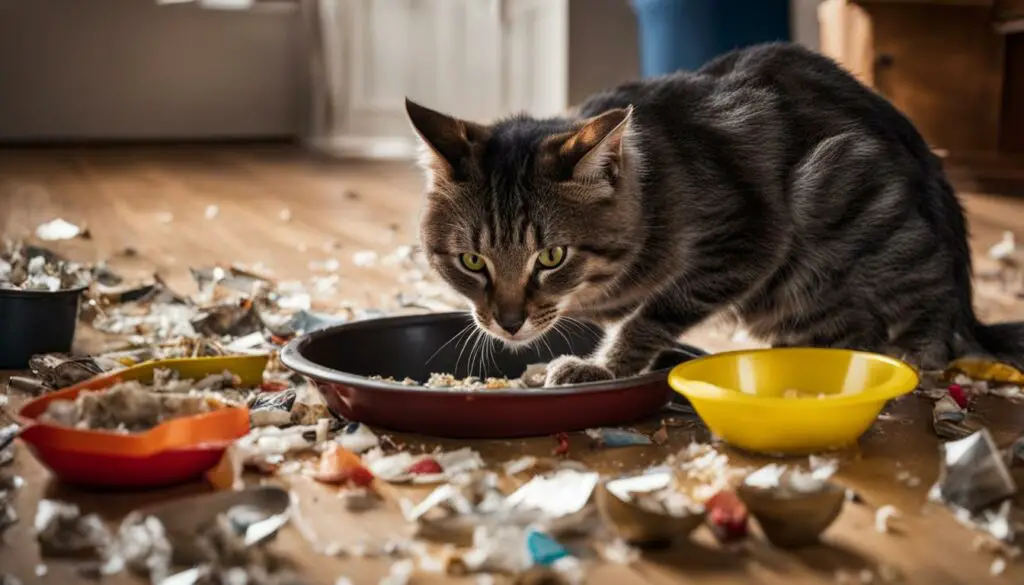
| Anxiety Symptoms in Cats | Common Causes |
|---|---|
| Excessive grooming | Poor socialization |
| Loss of appetite | Sudden changes in the environment |
| Aggression or hiding | Separation anxiety |
| Urinating or defecating outside the litter box | Previous traumatic experience |
Addressing anxiety in cats is crucial for their overall well-being and can help prevent unwanted behaviors like food bowl flipping. By creating a calm environment, using pheromone diffusers, and seeking professional advice, you can help your cat feel more secure and reduce the likelihood of food bowl flipping.
Getting a Heavier Food Bowl to Prevent Flipping
If your cat flips their food bowl by mistake due to the bowl being too light, consider getting a heavier food bowl. This can prevent accidental flipping and provide stability for your cat while eating. Ceramic bowls or bowls with a wide base are good options to prevent food bowl flipping.
When it comes to preventing cat food bowl flipping, the weight and stability of the bowl can make a big difference. Cats can be quite energetic while eating, and a lightweight bowl may easily tip over. By opting for a heavier food bowl, you can ensure that it stays in place even if your cat gets a little too excited during mealtime.
One option to consider is a ceramic bowl, which is generally heavier than plastic or stainless steel bowls. The weight of a ceramic bowl can help keep it stable on the floor, reducing the likelihood of flipping. Additionally, bowls with a wide base provide even more stability, making it harder for your cat to accidentally tip it over.
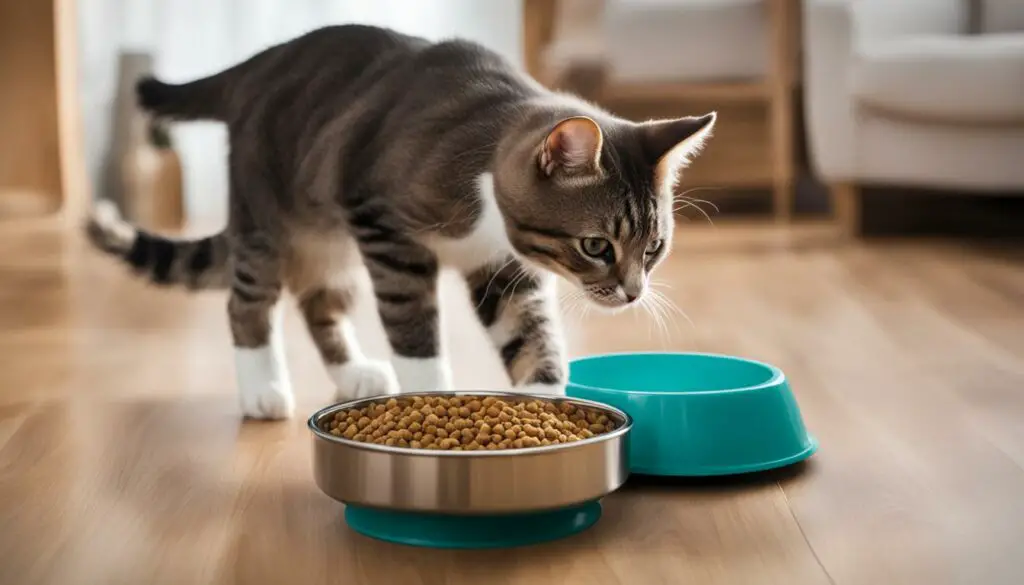
Alternative Options
If you prefer to explore alternative options, there are specialized bowls available specifically designed to prevent flipping. These bowls often feature a weighted bottom or a non-slip surface, adding extra stability to prevent tipping. Some even come with suction cups to secure the bowl to the floor or a feeding mat.
Another alternative is to use a slow feeder bowl, which has raised obstacles or ridges inside that force your cat to eat more slowly. This can help reduce mealtime excitement and minimize the chances of flipping the bowl. Slow feeder bowls can be particularly useful for cats who tend to eat too quickly, as they encourage a more controlled eating pace.
Summary
Preventing cat food bowl flipping can be achieved by considering the weight and stability of the bowl. Opting for a heavier ceramic bowl or one with a wide base can help keep the bowl in place, reducing the chances of accidental flipping. Alternatively, specialized bowls with weighted bottoms or non-slip surfaces can provide added stability. Slow feeder bowls can also help control mealtime excitement and prevent flipping. It’s important to choose a bowl that suits your cat’s needs and preferences to ensure a comfortable and enjoyable mealtime experience.
Getting a Bigger Bowl to Accommodate Whiskers
Many cats dislike feeling their whiskers against the sides or bottom of a bowl while eating. This can cause discomfort and lead to food bowl flipping behavior. To prevent this, it’s important to provide a bigger bowl that accommodates your cat’s whiskers.
A wide and shallow bowl allows cats to eat comfortably without their whiskers touching the sides. This ensures a pleasurable dining experience for your cat and reduces the likelihood of food bowl flipping. Consider choosing a bowl that is wider than your cat’s face to provide ample space for their whiskers.
By accommodating your cat’s whiskers with a larger bowl, you can help prevent food bowl flipping and create a more enjoyable mealtime for your feline friend.
Accommodating Whiskers: A Comparison
| Traditional Bowl | Bigger Bowl |
|---|---|
| Narrow and deep, causing whisker discomfort | Wide and shallow, allowing whiskers to remain free |
| Increased likelihood of food bowl flipping | Reduces the risk of food bowl flipping |
| May lead to anxiety and eating aversions | Promotes relaxed and comfortable dining |
As shown in the comparison table above, a bigger bowl that accommodates your cat’s whiskers can make a significant difference in preventing food bowl flipping. It not only eliminates discomfort but also promotes a more relaxed and enjoyable eating experience for your furry friend.
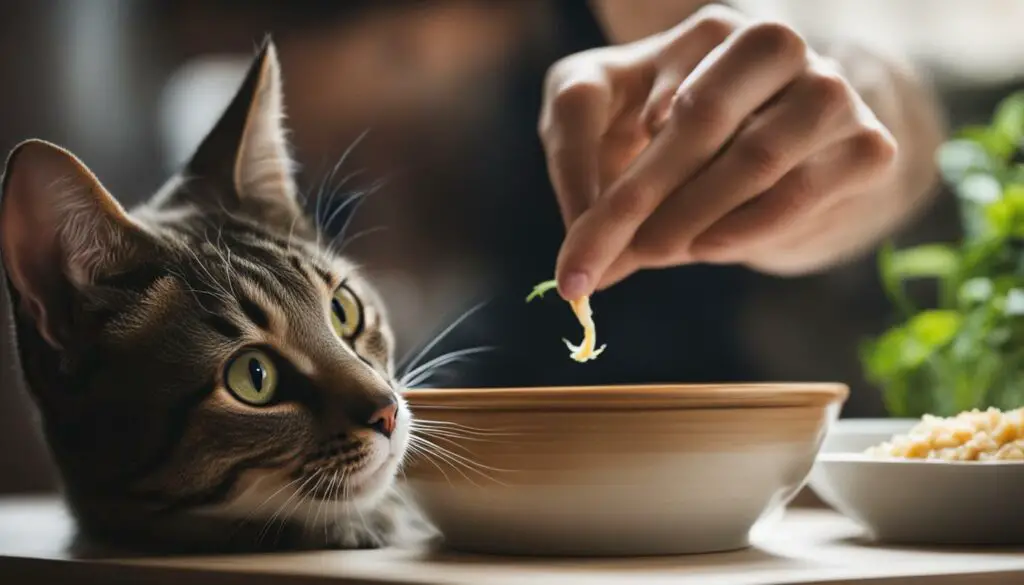
Remember, every cat is unique, so it’s essential to observe your cat’s behavior and preferences when choosing a bowl size. By providing a bigger bowl that accommodates their whiskers, you can help prevent food bowl flipping and create a happier dining experience for your beloved feline companion.
Trying a Feeder or Timed Feeding to Prevent Flipping
If your cat constantly flips their food bowl, you can try using a feeder or implementing timed feeding. A feeder distributes food to your cat on a schedule and is difficult to tip over. This alternative method of feeding can help prevent food bowl flipping and provide mental stimulation for your cat.
Feeding your cat using a timed feeder ensures that they receive their meals at specific times, reducing the opportunity for them to flip their food bowl. By establishing a consistent feeding schedule, you can regulate your cat’s eating habits and discourage the behavior of flipping their food bowl. Additionally, timed feeding can also be beneficial for weight management in cats.
Using a feeder or implementing timed feeding may require some training and adjustment for your cat. It’s important to introduce these methods gradually and provide positive reinforcement when your cat successfully uses the feeder or adapts to the new feeding schedule. Consult with a veterinarian or a pet behaviorist for guidance on how to effectively use a feeder or implement timed feeding for your cat.
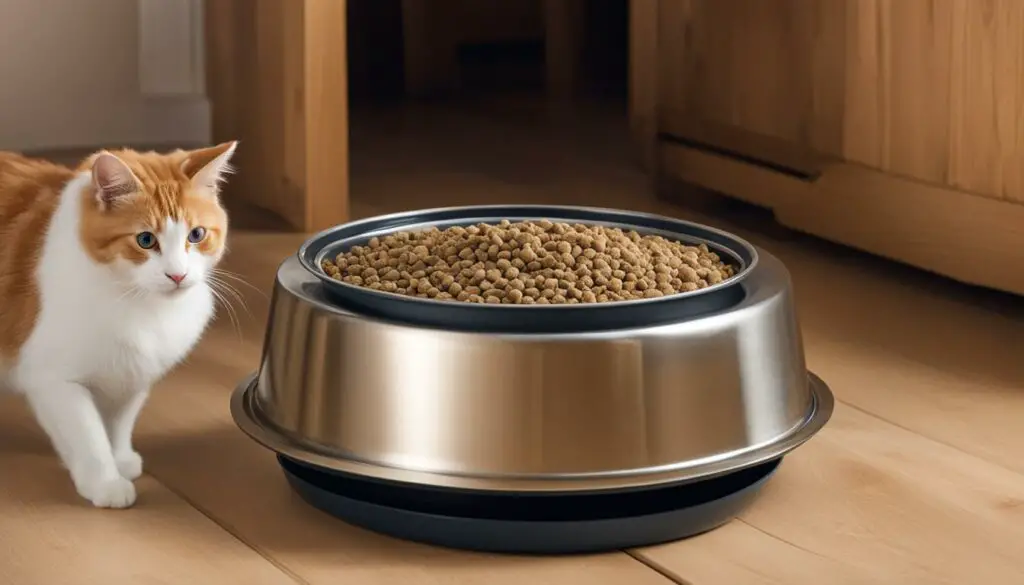
Table: Comparison of Feeding Methods
| Feeding Method | Advantages | Disadvantages |
|---|---|---|
| Traditional Food Bowl | Simple and familiar | May encourage food flipping behavior |
| Feeder | Reduces the opportunity for food bowl flipping | Requires training and adjustment |
| Timed Feeding | Regulates feeding schedule and promotes weight management | May require adjustment for the cat |
“Using a feeder or implementing timed feeding can be effective strategies to prevent food bowl flipping in your cat and promote a more controlled and predictable feeding routine.”
Experiment with different feeding methods to find the one that works best for your cat. Every cat is unique, and what works for one cat may not work for another. It’s important to be patient and persistent in finding the right solution to prevent food bowl flipping and ensure your cat’s feeding experience is enjoyable and stress-free.
Giving Your Cat More Attention to Reduce Flipping
If your cat is flipping their food bowl to seek attention, it’s important to provide more quality time and attention to your cat. Spending dedicated, interactive playtime with your cat each day can help fulfill their need for attention and reduce attention-seeking behaviors such as food bowl flipping. Building a strong bond with your cat through regular, positive interaction can have a positive impact on their behavior.
Why Cat Attention-Seeking Behavior Matters
Cats are social animals that require mental stimulation and companionship. When they don’t receive enough attention, they may engage in attention-seeking behaviors such as flipping their food bowl. By giving your cat more attention, you can help fulfill their social and mental needs, which can in turn reduce undesired behaviors.
Here are some ways to increase quality time with your cat:
- Dedicated play sessions: Engage in interactive play sessions with toys that stimulate your cat physically and mentally.
- Provide environmental enrichment: Set up a cat-friendly environment with scratching posts, climbing structures, and hiding spots.
- Give affection and grooming: Spend time petting and grooming your cat, as this can strengthen the bond between you and provide a sense of security.
- Create a routine: Establish a daily routine that includes regular feeding times, play sessions, and quiet, bonding moments.
By giving your cat more attention and meeting their social and mental needs, you can help reduce attention-seeking behaviors like food bowl flipping and promote a happier, more well-adjusted feline companion.

| Benefits of Increased Attention | Tips to Increase Quality Time |
|---|---|
| Reduced attention-seeking behaviors | Engage in interactive play sessions |
| Strengthened bond between you and your cat | Provide environmental enrichment |
| Improved overall behavior and well-being | Give affection and grooming |
| Promotion of a happier, more well-adjusted cat | Create a routine |
Feeding Cats Separately to Prevent Flipping
Preventing cat food bowl flipping can be achieved by feeding cats separately, which helps address competition for food. Cats are solitary eaters by nature, and providing individual feeding spaces can reduce stress and minimize the urge to flip their food bowls. By implementing this simple strategy, you can create a calm and harmonious feeding environment for your feline friends.
The benefits of feeding cats separately
Feeding cats separately not only prevents food bowl flipping but also promotes healthier eating habits. When cats compete for food, it can lead to overeating, resource guarding, and anxiety. By allowing each cat to have their own designated eating area, you can ensure that they consume their meals at a comfortable pace and feel secure while doing so.
Additionally, feeding cats separately can help you monitor their individual food intake more effectively. This is particularly beneficial if you have multiple cats with different dietary needs or if one cat requires a special diet. Each cat can receive the appropriate portion size and specific food that suits their nutritional requirements.
Implementing separate feeding areas
There are several ways to create separate feeding areas for your cats:
- Feed cats in different rooms: You can designate specific rooms or areas of your home for each cat’s mealtime. This ensures that they have their own space without feeling the need to compete or flip their food bowls.
- Feed cats at different times: If separate rooms are not feasible, feeding cats at staggered times can also be effective. This allows each cat to have uninterrupted access to their food without feeling rushed or threatened.
- Use dividers or barriers: If you prefer to feed your cats in the same room, you can use dividers or barriers to create separate eating areas. This can be done with baby gates, cat enclosures, or even cardboard screens to establish clear boundaries.
By implementing these methods, you can successfully prevent food bowl flipping and create a peaceful feeding environment for your cats, promoting their overall well-being.
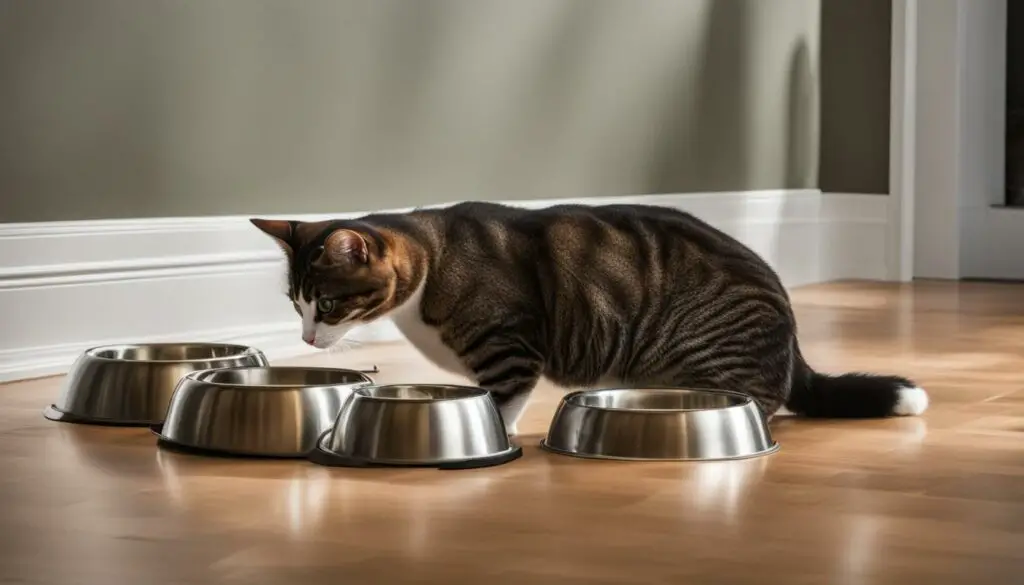
Table: Pros and cons of feeding cats separately
| Pros | Cons |
|---|---|
| Reduces competition and stress during mealtimes | Requires additional feeding areas or rooms |
| Allows for individualized dietary management | May require more time and effort to coordinate feeding schedules |
| Facilitates monitoring of food intake for each cat | May require adjustments and acclimation period for some cats |
| Promotes healthier eating habits and prevents overeating | Not suitable for all cat households, depending on dynamics and behaviors |
Other Methods of Feeding to Prevent Flipping
Cats are notorious for their quirkiness, and one common behavior that can perplex their owners is food bowl flipping. If your feline friend is constantly flipping their food bowl, there are alternative feeding methods that you can try to prevent this behavior. These methods can provide your cat with a more enjoyable and stress-free mealtime experience. Let’s explore some of these options:
1. Baking Trays or Flat Cat Plates
Instead of using a traditional food bowl, you can try offering your cat their meals on baking trays or flat cat plates. These options allow your cat to eat without their whiskers touching the sides, which can be a source of discomfort for some cats. The wide surface area of baking trays or flat cat plates provides ample space for your cat to eat comfortably.
2. Non-Slip Bowls
If your cat tends to flip their food bowl due to it moving around, consider using non-slip bowls. These bowls are designed with a rubber or silicone base that prevents them from sliding across the floor. The added stability can help prevent food bowl flipping and keep your cat’s meal in place.
3. Puzzle Feeders
Puzzle feeders are interactive toys that require your cat to work for their food. These feeders stimulate your cat’s natural hunting instincts and provide mental stimulation during mealtime. Not only do puzzle feeders prevent food bowl flipping, but they also help slow down your cat’s eating pace, which can aid in digestion.
| Feeding Method | Benefits |
|---|---|
| Baking Trays or Flat Cat Plates | Prevents whisker discomfort |
| Non-Slip Bowls | Provides stability and prevents bowl movement |
| Puzzle Feeders | Stimulates mental activity and slows down eating |
By incorporating these alternative feeding methods into your cat’s routine, you can reduce or eliminate food bowl flipping behavior. Remember, each cat is unique, so it may take some trial and error to find the method that works best for your feline friend. Observe your cat’s behavior and preferences to ensure they are comfortable and enjoying their meals.
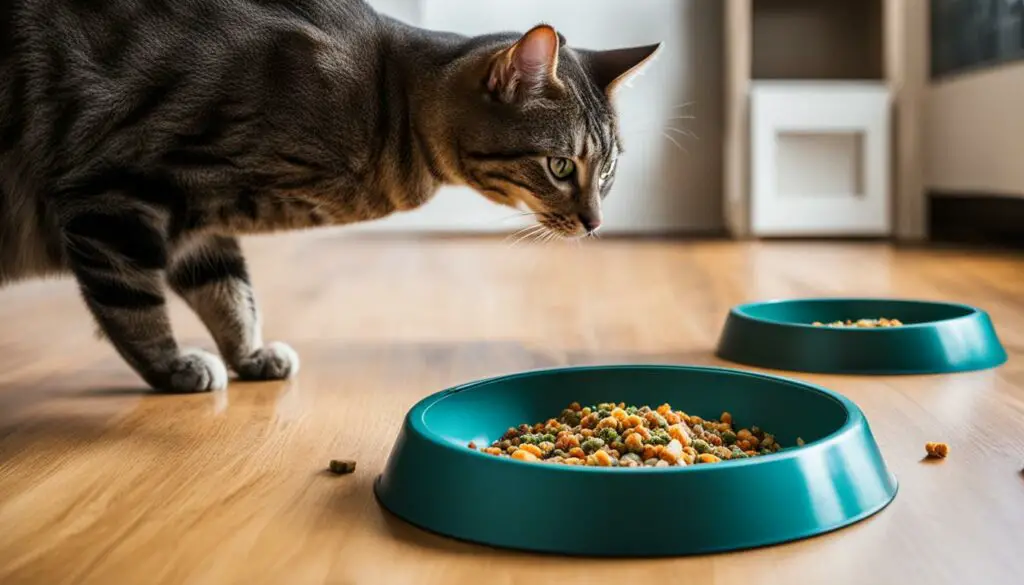
Addressing Anxiety to Reduce Flipping
Addressing anxiety in cats is crucial for reducing food bowl flipping behavior. Cats may flip their food bowls due to stress or frustration, so it’s important to create a calm and secure environment for your cat. Providing hiding spots, such as cat trees or enclosed beds, can give your cat a sense of security and help reduce anxiety.
Using pheromone diffusers, such as Feliway, can also help calm anxious cats. These diffusers release synthetic pheromones that mimic the ones cats produce naturally to mark their territory as safe and familiar. Placing a diffuser near your cat’s eating area can help create a stress-free environment and reduce the urge to flip their food bowl.
If your cat’s anxiety is severe or persistent, it may be helpful to consult with a veterinarian or a pet behaviorist. They can provide guidance on additional techniques or treatments, such as behavioral therapy or medication, to address your cat’s anxiety and reduce food bowl flipping.
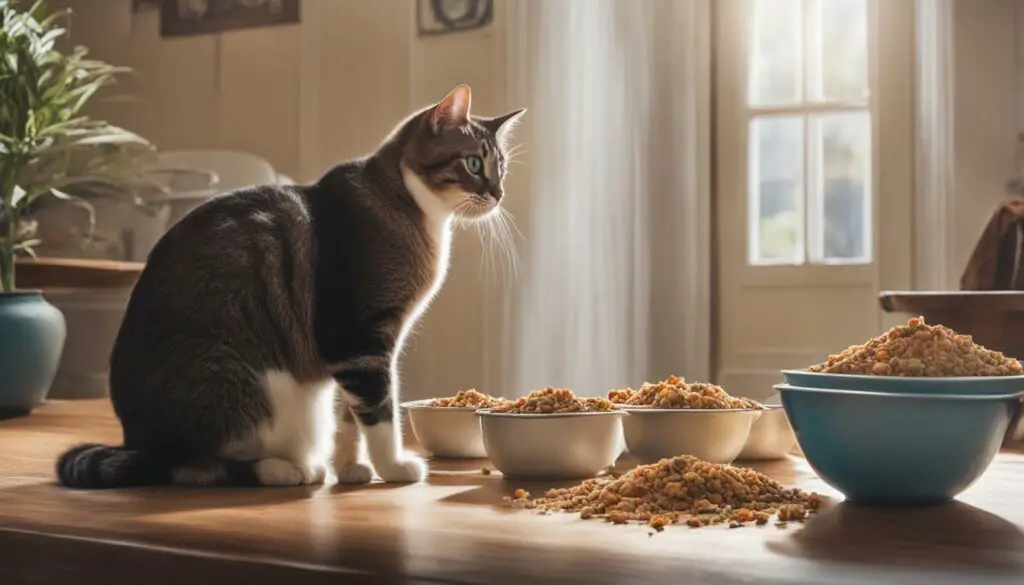
Table: Tips for Addressing Cat Anxiety
| Tip | Description |
|---|---|
| Create a calm environment | Provide hiding spots and vertical space for your cat to feel safe and secure. |
| Use pheromone diffusers | Placing a Feliway diffuser near your cat’s eating area can help reduce anxiety. |
| Consult with a professional | If your cat’s anxiety is severe or persistent, seek guidance from a veterinarian or pet behaviorist. |
Note: It’s important to remember that each cat is unique, and what works for one cat may not work for another. Be patient and persistent in finding the right strategies to address your cat’s anxiety and reduce food bowl flipping behavior.
Maintaining General Hygiene: Grooming After Eating
Cats have a natural instinct to groom themselves, and this includes grooming after eating. It is an important part of their routine that helps them maintain general hygiene. After a meal, cats engage in grooming behavior to remove food debris and clean their mouth and paws. Licking their mouth helps remove any traces of food, while licking their paws helps remove food residue and debris from their face.
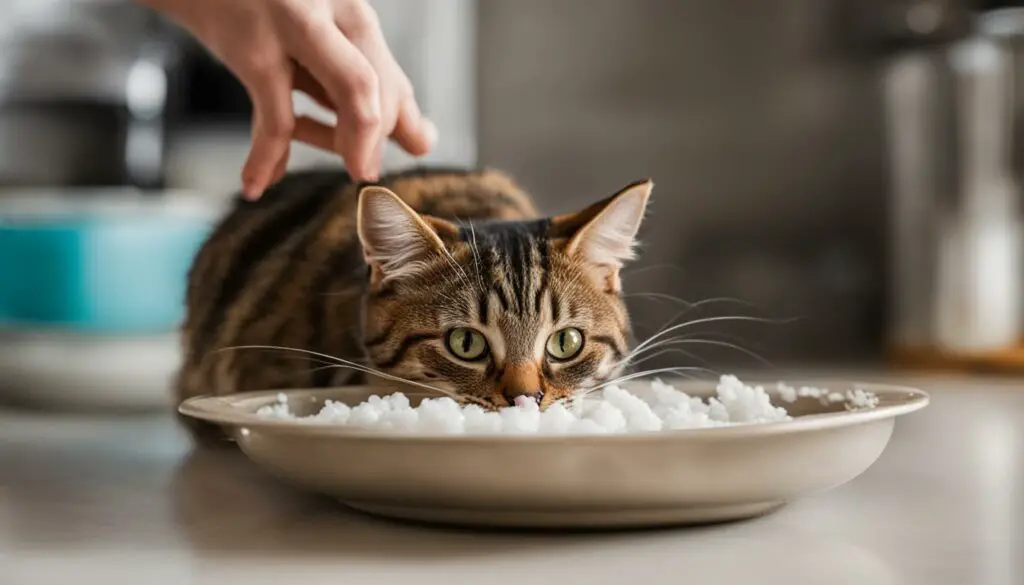
This post-meal grooming behavior is learned from early kittenhood and is an essential part of a cat’s routine. It not only keeps them clean but also serves other purposes, such as regulating their body temperature, stimulating blood circulation, and maintaining healthy skin and coat. The act of grooming also provides cats with a sense of comfort and relaxation.
Grooming is an instinctive behavior in cats, and it helps them maintain their overall health and well-being. It is important for pet owners to recognize and appreciate this natural behavior in their cats. Providing a clean and safe environment, regular brushing to prevent matting, and ensuring proper nutrition are all essential in supporting your cat’s grooming needs.
Understanding Normal Grooming Behavior
Grooming is an essential behavior for cats, serving both practical and social purposes. By grooming themselves, cats not only keep their fur clean and free from dirt but also distribute natural oils that help maintain the health and integrity of their coats. Additionally, grooming serves as a social bonding activity among cats, as they often groom each other to strengthen their relationships and promote harmony within their social group.
Cats have specialized tongues with tiny barbs that assist in removing dirt, debris, and parasites from their fur. Their grooming ritual typically involves licking their bodies from head to tail, paying special attention to areas that are harder to reach, such as the back of the neck and the base of the tail. They also use their front paws to wipe their faces, clean their ears, and remove any lingering food particles. This comprehensive grooming routine ensures that cats maintain excellent hygiene and overall cleanliness.
Grooming behavior in cats is considered normal as long as it does not become excessive or compulsive. Normal grooming habits can vary among cats, with some being more fastidious groomers than others. The frequency and duration of grooming sessions can also differ based on factors such as the cat’s breed, age, and individual preferences. It’s important to note that occasional grooming can result in small clumps of fur being ingested, which typically passes through the digestive system without causing any harm.
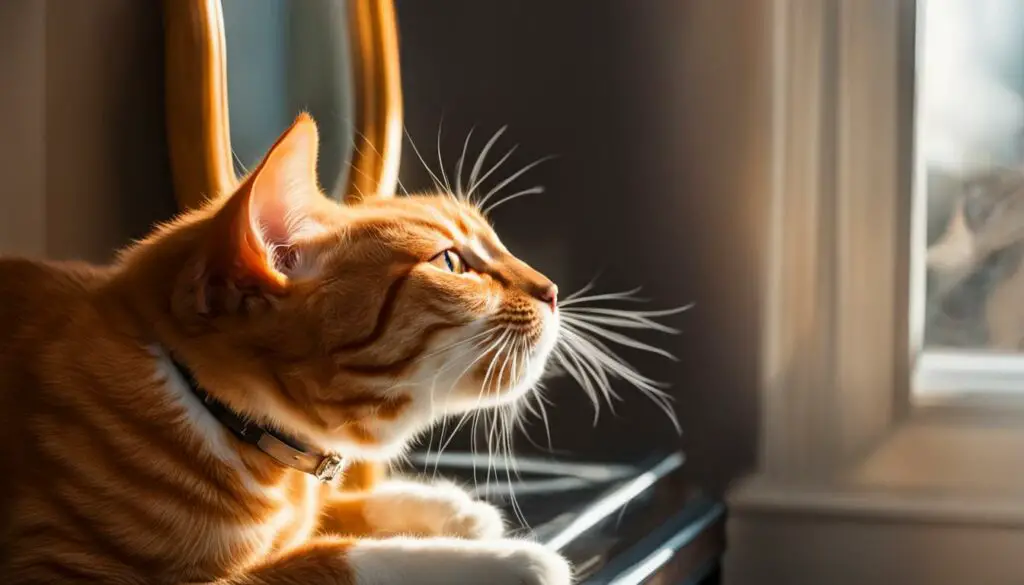
Excessive Grooming and Psychogenic Alopecia
Excessive grooming, also known as psychogenic alopecia, is a compulsive behavior that some cats may exhibit. It involves excessive grooming to the point of causing hair loss and skin irritation. This condition can be distressing for both cats and their owners, and it is important to understand its causes and explore potential solutions.
Cats may engage in excessive grooming as a response to stress, anxiety, or other underlying medical conditions. It can serve as a coping mechanism, providing temporary relief from emotional discomfort. As a result, cats may overgroom certain areas of their bodies, leading to hair loss and skin inflammation.
To address excessive grooming in cats, it is crucial to identify and address the root cause. If stress or anxiety is suspected, creating a calm and secure environment for the cat can help alleviate their distress. Providing enrichment activities, such as puzzle toys or interactive play sessions, can also help redirect their energy and reduce the urge to groom excessively. Additionally, consulting with a veterinarian is essential to rule out any underlying medical issues that may be contributing to the behavior.
| Causes of Excessive Grooming | Solutions |
|---|---|
| Stress and anxiety | Creating a calm environment Providing enrichment activities Consulting with a veterinarian |
| Underlying medical conditions | Consulting with a veterinarian for diagnosis and treatment |
It is important to keep in mind that resolving excessive grooming may require a combination of management techniques and patience. It may take time to identify the underlying cause and implement the appropriate solutions. With proper care and attention, cats can find relief from excessive grooming and enjoy improved overall well-being.
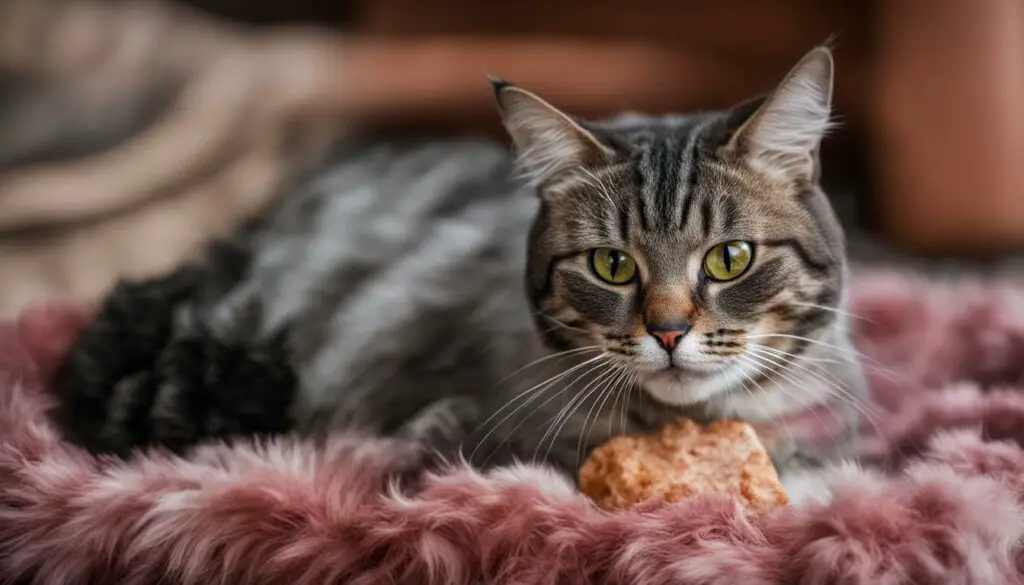
Conclusion
Understanding why cats flip their food bowls is essential for addressing and preventing this behavior. Cats may flip their food bowls due to discomfort, attention-seeking, food or bowl preferences, or anxiety. To prevent food bowl flipping, it’s important to provide suitable bowls, address anxiety, and give your cat the attention it needs.
One common reason for food bowl flipping is discomfort caused by small or narrow bowls. By choosing wider and shallower bowls, you can ensure that your cat can eat comfortably without their whiskers touching the sides. Additionally, some cats flip their food bowls as a way to get attention. By dedicating regular playtime and attention to your cat, you can fulfill their need for interaction and reduce attention-seeking behaviors like food bowl flipping.
Another important factor to consider is your cat’s food preferences. Cats may flip their food bowls if they dislike the food or bowl itself. Offering a variety of food options and experimenting with different flavors can help you find the food that your cat enjoys. It’s also crucial to address any underlying anxiety in your cat, as anxiety can lead to food bowl flipping. Consulting with a veterinarian or pet behaviorist can provide valuable insights and guidance on managing anxiety in your cat.
By taking these steps and understanding your cat’s behavior, you can prevent or minimize food bowl flipping. Remember, every cat is unique, so it may take some trial and error to find the best solutions for your furry friend. With patience, care, and a little training, you can help your cat develop good eating habits and enjoy mealtime without flipping their food bowl.
FAQ
Why does my cat flip his food bowl?
Cats may flip their food bowls for various reasons, including discomfort, attention-seeking, dislike of the food or bowl, or anxiety.
How can I prevent my cat from flipping his food bowl for attention?
To prevent food bowl flipping for attention, it is important to provide dedicated playtime and attention to your cat on a regular basis.
What should I do if my cat doesn’t like the food I provide?
Different cats have different food preferences, so it’s important to offer a variety of options to find the food that your cat enjoys. Wet food or a combination of wet and dry food is generally recommended for cats.
Can the type of bowl I use contribute to food bowl flipping behavior?
Yes, some cats may not like deep or narrow bowls that touch their whiskers while eating. It’s important to choose a bowl that is wide, shallow, and made of materials that your cat prefers, such as BPA-free plastic, ceramic, or metal.
How can I address anxiety in my cat to prevent food bowl flipping?
It’s important to address the underlying cause of anxiety in your cat to prevent food bowl flipping. Common causes of anxiety in cats include illness or physical pain, trauma, poor socialization, and separation anxiety. Consulting with a veterinarian or a pet behaviorist can help identify and address the anxiety in your cat.
Should I get a heavier food bowl to prevent flipping?
If your cat flips their food bowl by mistake due to the bowl being too light, consider getting a heavier food bowl. Ceramic bowls or bowls with a wide base are good options to prevent food bowl flipping.
How can I accommodate my cat’s whiskers to prevent food bowl flipping?
Providing a bigger bowl that accommodates their whiskers can help prevent food bowl flipping. A wide and shallow bowl allows cats to eat comfortably without their whiskers touching the sides.
What other methods of feeding can prevent food bowl flipping?
If your cat constantly flips their food bowl, you can try using a feeder or implementing timed feeding. A feeder distributes food to your cat on a schedule and is difficult to tip over. You can also place a flat surface underneath the feeder to prevent messes.
How can I give my cat more attention to reduce food bowl flipping?
Spending dedicated, interactive playtime with your cat each day can help fulfill their need for attention and reduce attention-seeking behaviors such as food bowl flipping. Building a strong bond with your cat through regular, positive interaction can have a positive impact on their behavior.
Should I feed my cats separately to prevent food bowl flipping?
Yes, feeding cats separately can help prevent food bowl flipping caused by competition for food. Feed your cats at different times or in separate rooms to ensure they have their own space to eat without feeling the need to flip their food bowls.
Are there alternative feeding methods to prevent food bowl flipping?
If traditional food bowls don’t work for your cat, there are other methods of feeding that can help prevent food bowl flipping. Some cats prefer eating from baking trays or flat cat plates, as these allow them to eat without their whiskers touching the sides. Non-slip bowls can also prevent food bowl flipping caused by the bowl moving around.
How can I address and manage anxiety in my cat to reduce flipping?
If your cat is flipping their food bowl due to anxiety, it’s crucial to address and manage their anxiety to reduce flipping behavior. This can involve creating a calm and secure environment for your cat, providing hiding spots, and using calming techniques such as pheromone diffusers. Consulting with a veterinarian or a pet behaviorist can provide additional guidance on how to address anxiety in your cat.
Why do cats groom themselves after eating?
Cats groom themselves after eating as part of their natural instinct and to maintain general hygiene. Grooming helps remove food debris and clean the mouth and paws.
What is normal grooming behavior in cats?
Normal grooming behavior in cats involves licking their fur to remove dirt, excess fur, and parasites. Cats have specialized tongues with small barbs that help them groom effectively. They also use their paws to scrub their faces and ears. Normal grooming behavior is essential for maintaining healthy skin, indicating overall health, and social bonding among cats.
What is excessive grooming and psychogenic alopecia?
Excessive grooming, also known as psychogenic alopecia, is a compulsive behavior that some cats may exhibit. It involves excessive grooming to the point of causing hair loss and skin irritation. Excessive grooming can be a sign of stress, anxiety, or other underlying medical conditions. It is important to consult with a veterinarian if you notice excessive grooming in your cat to determine the cause and provide appropriate treatment.

